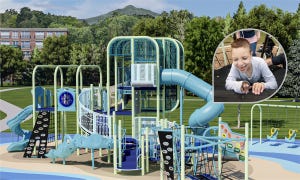Dr. Stuart Brown pioneered a study that linked criminal behavior in adulthood to a lack of play in childhood. Since then, he's dedicated his research to building psychological profiles that draw a strong correlation between success and play. One of the conclusions he is able to make is this: play that engages the mind, body, and senses of a child provides benefits that will help them become a well-adjusted adult.
“Play energizes us and enlivens us. It eases our burdens. It renews our natural sense of optimism and opens us up to new possibilities.”- Dr. Stuart Brown
Play is a developmental necessity that will affect children for the rest of their lives. While it's easy to focus on the visible benefits of physical play and activity, let's take a cue from Dr. Brown and look a little deeper.
Read on to learn about the critical role sensory play has in a child’s life and how you can make a difference.
The Benefits of Sensory Play
Sensory skills are a critical developmental milestone among children. Children learn through engaging with the world around them, and the senses help process what they encounter.
If a child picks up an object, the identification process compares it to what they have already engaged with. If it looks like a rock, feels like a rock, and sounds like a rock when thrown- it is most likely a rock.

The best method for refining these sensory skills is through sensory play. Children encounter many different sights, sounds, smells, textures, and pressures when playing. This exposure helps them learn to process many senses at once.
Sensory play is helpful beyond developing sensory skills. School psychologists share how sensory play helps develop the following:
- Language
- Coordination
- Body awareness
- Cognitive abilities
- Problem-solving skills
Learning Through the Senses
Some people think sensory play and learning are separate activities, but research states the two complement each other.
When children learn in an environment that stimulates many senses at once, they will create new neuropathways faster and better understand the material. An excellent example of sensory play in schools would be engaging the students in an activity that uses the five senses to learn a new math fact.
Teachers have limited resources that prevent sensory learning from being a daily standard. When tasked to find a way around this issue, a school in Manitoba stepped up to the plate by installing a sensory path in the hallway.
The sensory path consists of stickers on the ground and walls that task students with activities that engage the senses. These tasks range in difficulty from running across a log to jumping from raindrop to raindrop.
Teachers reported that children complete the path before class starts to help burn energy and stay focused. Teachers dismiss individual students who need to take a break and complete the path.
Not only is the sensory path great for relieving pent-up energy, but it also teaches children how to listen to their bodies and express their needs.
Supporting the Needs of the Neurodivergent
Research states that 1 in 54 children have a diagnosis of autism by age eight, and 1 in 15 children will have a diagnosis of ADHD by the same age. Most elementary schools likely consist of a neurodivergent population.
Neurodivergence describes people who process stimuli differently. This means they might need resources to accommodate their unique neuropathways.
One of the best ways to support neurodivergent children in school is through investing in sensory play opportunities. Sensory play helps this group of children get their big emotions out and become better learners. It is also a great preventative measure for emotional outbursts and builds confidence in their sense of self.
How to Make a Difference With Sensory Playground Equipment
Sensory play is not a “one size fits all.” All children uniquely process sensory input.
Children with sensory processing issues can either be oversensitive or under-sensitive to stimuli. One child may get overwhelmed by loud music, while another likes to turn the volume as high as it will go even if they can hear fine.
 GameTime has many innovative sensory playground equipment options that can be part of a sensory-rich playground environment.
GameTime has many innovative sensory playground equipment options that can be part of a sensory-rich playground environment.
Here are some sensory playground equipment options:
GT Sensors: Pick a few auditory, visual, and tactile sensors and install them as freestanding panels or play system components. Sensory panels can also be installed within the Sensory Wave Arch Climber to integrate full-body movement.
Elevated SandBox: Our elevated table is ADA accessible and perfect for children of all abilities. Consider filling with water, smooth pebbles, dry rice or beans, or other materials to provide different sensory experiences.
Sensory Car Wash: This accessible and inclusive play tunnel includes weighted flexible panels that apply slight pressure as you pass through.
Swings: Promotes sensory destressing through vestibular movement. Our Expression Swings also assist with sensory processing as participants are positioned face-to-face and eye-to-eye.
Poured in Place Rubber Surfacing: Customizable accessible surfacing that can create a sensory path. Combine this with the Agility Pods or the Curved Balance Beam to create a more engaging experience.
Challenge Course: Fun high-energy “Ninja Warrior” style sensory path and outdoor obstacle course.
Making Sense of Sensory Play
Sensory play at school is a necessity for helping children learn. When children engage with many sensory sources at once, they can develop neuropathways and better comprehend classroom subject matter.
Sensory play also allows children to manage the emotions that hinder their learning. This is especially helpful for neurodivergent children who need extra support when processing their feelings.
Installing sensory playground equipment helps children learn at their full potential. Contact a GameTime representative today to install a playground that considers the needs of everybody.





